Check out my custom vibration dampener
Tennis Net Height
Measurements, Strategy, & More
We hope you love this article. Just so you know, TennisCompanion may collect a small share of sales from the links on this page to help keep this site running.
Nets are an essential piece of equipment in tennis, which divide a court in half and provide players with one of the primary obstacles they must clear when playing a point.
According to the International Tennis Federation’s Rules of Tennis, a net should be 3.5 feet at the sides and 3 feet at the center. As straightforward as it may seem, there are some nuances to keep in mind, especially when playing singles vs. doubles, that players often overlook.
This article provides all of the essential details regarding tennis net height, including strategy considerations, how tennis nets compare to related sports, and more. Let’s dive in!
Article Contents
Click below to jump to a section
Tap below to jump to a section
Official Rules
Net Height & Strategy
Net Height Comparisons
Measuring a Net’s Height
Adjusting a Net’s Height
Net Measurement Checkers
New to TennisCompanion?
Create a free account and explore my latest videos below
Official Rules
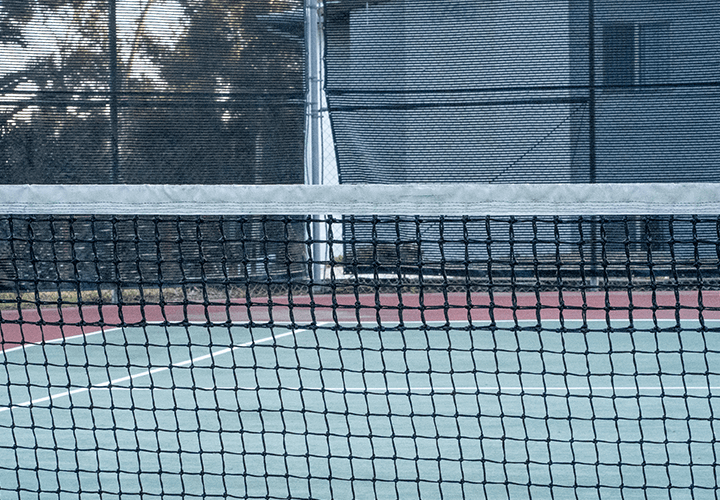
You can rely on a few different sources to determine the proper height of a tennis net. However, the International Tennis Federation (ITF) and the United States Tennis Association (USTA) are two of the most highly referenced tennis rules and regulations resources.
For context, the ITF is the governing body of tennis. Its rules are what the Association of Tennis Professionals (ATP) and Women’s Tennis Association (WTA) use for officiating all professional tennis matches.
According to ITF regulation and USTA guidelines, a tennis net should attach to two net posts at the side of a court with a height of three and a half feet. Then, it should be held down tightly by a strap so the net is three feet at the center. Here’s how that converts to other measurements.
| Measurement | Height at Posts | Height at Center |
| Feet | 3′ 6″ | 3′ |
| Inches | 42″ | 36″ |
| Meters | 1.07m | 0.91m |
| Centimeters | 106.7cm | 91.4cm |
However, equally important is the placement of the net posts, which the dimensions of a tennis court influence. For singles, the net posts should be three feet outside the singles court, while for doubles, the net posts should be three feet outside the doubles court.

Although some tennis courts have post anchors for singles and doubles nets, most don’t. Instead, the side posts are anchored three feet outside the doubles court for playing singles and doubles.
I’ve included an example of singles posts below.
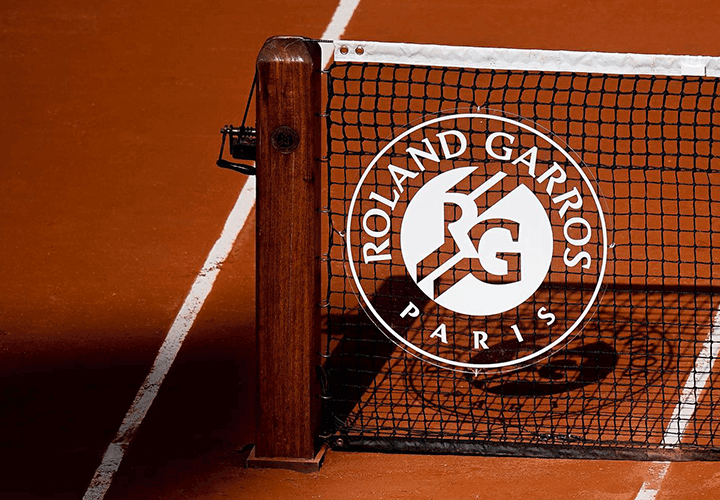
Photo Credit: @rolandgarros
If that’s the case, players should use singles sticks that prop the net up to the appropriate height three feet outside the singles court. Otherwise, the net will be lower than it should be when playing singles.
In the photo below, you’ll see the court uses singles sticks.

Photo Credit: @rafaelnadal
Why is a tennis net lower in the middle?
A tennis net is lower or sags in the middle because gravity pulls it down, and it’s not reasonably possible to apply enough tension to the net cord or metal cable to make it straight all the way across the court.
However, after hanging a tennis net, a center strap pulls the net further down to add a unique element or strategy of play where it’s easier to clear the net in the middle than at the sides.
Net Height & Strategy
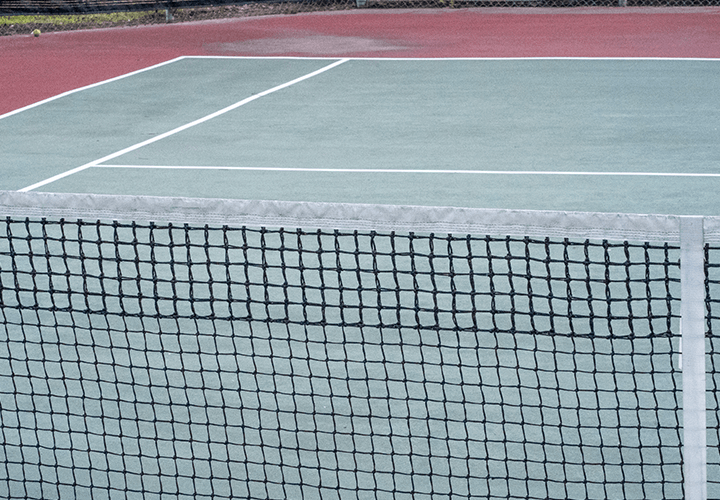
Although the difference in the height of six inches from the sides of the net to the middle might not seem like a large margin, it significantly influences a player’s strategy and shot execution.
For context, think of the last time you experienced a tennis ball hitting the top of the net. It happens surprisingly often.
Here are a few examples to help paint a clearer picture.
Down the Middle & Crosscourt
Generally, hitting a ball over the center of the net offers players a higher margin for error, i.e., you’ll be less likely to miss. It’s true whether you’re playing down the middle or crosscourt.
You’ll see many points where players repeatedly hit the ball down the middle of the court, waiting for their opponent to hit the ball poorly, at which time they’ll capitalize on the mistake.
Down the Line
Hitting down the line is a more challenging low percentage shot for two main reasons. First, you need to be accurate because you’re aiming for a small portion of the court near the sideline. Second, the net is higher at the sides, so the ball has to clear the net higher.
If you hit a ball out wide to your opponent’s court and approach the net, it’s usually advantageous to avoid hugging the sideline too much because you give them a sizeable crosscourt target to pass you.
Also, covering the crosscourt pass forces your opponent to hit a low percentage down the line shot, which they’ll often miss due to pressure.
Serving
When hitting a serve, the net’s height is also a factor to consider. If you’re hitting a hard flat serve with little spin, you’ll give yourself some extra margin for error by serving up the “T,” i.e., down the middle.
Although many players will frequently hit slice serves to pull their opponent off the court, a slice down the middle can be equally effective while giving yourself a bit of extra height to work with and increasing your likelihood of successful execution.
Net Height Comparisons
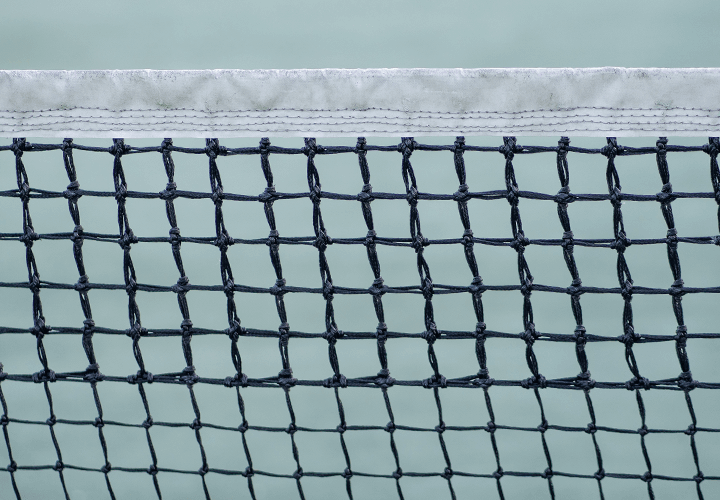
Nets are common in various sports, but each has unique regulations for what constitutes the correct net height. Even in junior tennis, the height of the net differs in the early stages of learning the game.
Let’s look at how height differs for some common racquet sports.
Junior Tennis
When kids are first learning how to play tennis, they’ll use a different net height than adults. The USTA refers to their children’s program for tennis as 10 and Under Tennis, which has four divisions or stages: red, orange, green, and yellow.
During the initial red division, intended for kids eight years or younger, children play tennis on a court that’s 36 feet in length and 18 feet in width. The net height at this stage should measure two feet nine inches tall.
However, once children progress to the orange stage, they begin using the standard net height, that’s three feet six inches at the side and three feet at the center or middle of the net. Here’s a table outlining the various stages and the appropriate net heights for junior tennis.
| Division | Net Height |
| Red | 2′ 9″ |
| Orange | 3′ 6″ at net posts / 3′ center |
| Green | 3′ 6″ at net posts / 3′ center |
| Yellow | 3′ 6″ at net posts / 3′ center |
Pickleball
In the past few years, pickleball has exploded in popularity. If you’re transitioning from tennis to pickleball or vice versa, you might wonder how the net height differs. Here’s how they stack up.
| Sport | Sides | Center |
| Tennis | 3′ 6″ / 42″ / 106.7cm | 3′ / 36″ / 91.4 cm |
| Pickleball | 3′ / 36″ / 91.4cm | 2′ 10″ / 34″ / 86.4 cm |
The above pickleball net heights coincide with the official measurements provided by the USA Pickleball Association (USAPA).
The sides of a tennis net are six inches higher than a pickleball net, while the center is only two inches higher.
Pickleball nets are a bit shorter than tennis nets to accommodate for the smaller court size, but they’re not too far off in terms of height.
Paddle
Otherwise known as platform tennis, paddle tennis is a close cousin to pickleball, but it’s been around for longer, and unique rules and regulations apply to both.
As far as the net for paddle tennis, it’s also different than tennis. Here’s a quick comparison of the net heights for the two.
| Sport | Sides | Center |
| Tennis | 3′ 6″ / 42″ / 106.7cm | 3′ / 36″ / 91.4 cm |
| Paddle | 3′ 1″ / 37″ / 94cm | 2′ 10″ / 34″ / 86.4 cm |
The above paddle measurements for net height are consistent with what you’ll find in the American Platform Tennis Association’s (APTA) rulebook.
When comparing, a tennis net is five inches taller at the sides and two inches higher at the center.
Beach Tennis
Another up-and-coming sport is beach tennis, which has many similarities to tennis. However, one area where they differ significantly is net height, which is considerably higher for beach tennis.
Furthermore, the net height varies for men and women. Here’s how the two sports compare.
| Sport | Sides | Center |
| Tennis | 3′ 6″ / 42″ / 1.07m / 106.7cm | 3′ / 36″ / 0.91m / 91.4 cm |
| Beach Tennis (Men) | 5′ 11″ / 71″ / 1.8m / 180cm) | 5′ 11″ / 71 / 1.8m / 180cm |
| Beach Tennis (Women) | 5′ 7″ / 67″ / 1.7m / 170cm) | 5′ 7″ / 67″ / 1.7m / 170cm |
It’s worth noting that the official heights for beach tennis nets are expressed in meters, i.e., 1.8m and 1.7m for exactness. In the above table, I’ve rounded for feet and inch measurements.
Also, as you can see from the above measurements, beach tennis nets are the same height in the middle as they are on the sides.
How to Measure a Tennis Net’s Height

Measuring a tennis net is super straightforward. Next time you head to a tennis court to play, bring a measuring tape that extends to three feet.
Once you’re on the court, all you have to do is break out your measuring tape and measure straight up and down from the center of the net, where you’ll find the center strap or white band attached to the ground.
I keep a small measuring tape in my bag to measure the net at public courts in particular, which no one checks regularly. Many tennis clubs will measure their nets semi-regularly, but it still doesn’t hurt to check regardless of the court.
How to Adjust a Tennis Net’s Height
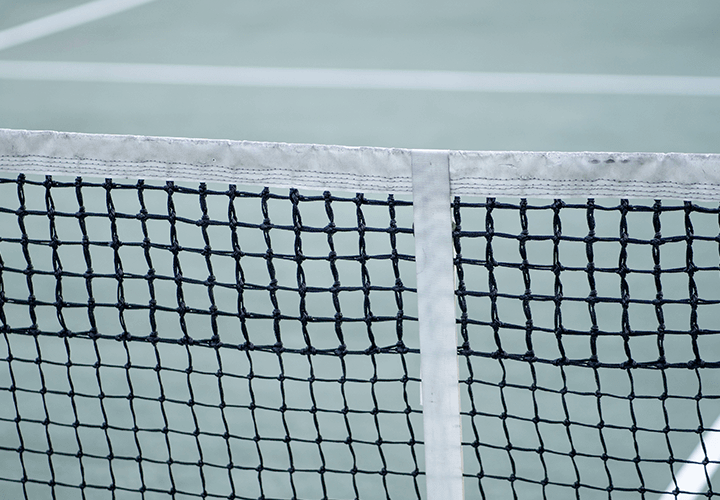
If you measure your tennis net and it’s too high or low, you can easily adjust it with the center strap, which wraps around the net and anchors to the ground to bring the net’s height down in the middle.
Grab the white strap above or below the metal buckle, then pull to tighten if you need to drop the net’s height. Alternatively, feed the strap through the buckle if you need to increase the net’s height.
The older the center strap, the fussier they can be, so you may have to be patient when adjusting them. It’s worth noting that some center straps are of higher quality and hold their position better.
If the court you play on has a cheap center strap, you’ll likely have to check the height regularly, especially outdoors, as the elements, including wind, can slowly loosen the strap.
Raising the Net Further
If you completely loosen the center strap and are still not at the required three feet or 36 inches, you’ll need to tighten the net cord.
One of the tennis posts will have a reel that you can crank tighter with a handle to raise the net’s height. However, the handles are often removable, so the local parks and rec team will take them off, so people don’t mess with the nets or steal the handle.
If that’s the case, you have two options. You can get in touch with the local parks and rec office and ask them to come out and raise the height of the net, which most will happily do for you.
Alternatively, you can use a wrench or pliers to adjust the net’s height. If you don’t know what you’re doing, you can damage or scratch the hardware, so do so at your own risk, but it’s possible to do.
Singles Sticks
Most public courts use a doubles net and will not provide singles sticks, so you’ll need to bring them if you want to adjust the net to play singles at the correct height.
Luckily, singles sticks are pretty affordable. Here are a few options.
To use them, you’ll still need a measuring tape. Measure three feet outside the singles sideline at the net.
Mark the spot, then place your singles stick straight up and down to bring the height at the sides of the net up to three feet six inches.
Although rare, some tennis courts have singles and doubles post anchors. You’ll see this at some of the Grand Slam events, including Wimbledon. If the court you’re playing has singles posts, you won’t need to use singles sticks as the posts will already be at the correct height.
Net Measurement Checkers
A handy device for quickly and easily checking the height of a tennis net at the center, net checkers are compact and easily fit into your bag.
When extended to their full length, they measure three feet, so you can hold them up to the center of the net to quickly and easily verify a net’s height. Here are a few you might want to check out.
Of course, a simple measuring tape like Amazon Basics 16-feet tape measure will do the trick, and all of them fit easily in your bag.
Wrapping Up
If you play tennis regularly, knowing the proper height of a tennis net is practical to help ensure you’re playing by the rules. Plus, next time you hit the net cord, you can be confident the net’s at the right height, and the net didn’t rob you of a point if it doesn’t go your way.
Although the topic is relatively straightforward, I hope you found the information I covered helpful beyond the exact measurement. If you have any further questions about net height or tennis courts more broadly, please don’t hesitate to comment below.
Play Better Tennis
Improve your game alongside our community of tennis players
Why join?
Discussion Boards
Join the conversation with other members of the community.
5 Point Friday
Read our weekly recap of the 5 most interesting things we dig up in tennis.

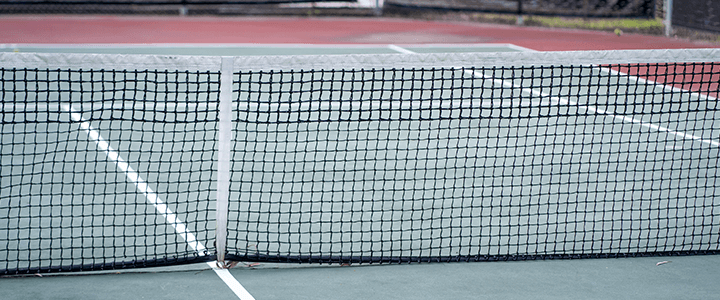

Leave a Reply
Want to join the discussion?Feel free to contribute!